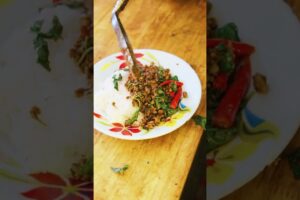
If you’re looking for marvelous hand-made soba noodles in Tokyo go to Narutomi (手打ち蕎麦 成冨): http://migrationology.com/2014/06/narutomi-soba-restaurant-tokyo/
I had eaten Japanese soba noodles quite a few times in my life, normally from Japanese buffets or at cheap restaurants outside of Japanese. But along with eating platters of fresh sashimi and bowl of ramen, one of the things I wanted to do when I was in Tokyo was eat a read hand-made meal of soba noodles. As a recommendation from Yukari, a friend of mine, we decided to go to a restaurant known as Narutomi Soba (手打ち蕎麦 成冨) in Tokyo, Japan to sample their soba noodles, and I was thrilled.
We got there for lunch, a little before they were open, and we were the first ones in the door. The menu was all in Japanese, so it was a little difficult to explain what I wanted to eat. However, at Narutomi Soba (手打ち蕎麦 成冨) they really only specialize in soba noodles, but they do serve them in a number of different way. The waitress was very kind to us, sat us down, and despite no English being on the menu, she explained to us what we could order. I knew I wanted to get the dry version, known as seiro soba or mori soba (盛り蕎麦), and so we each got one of those. At Narutomi, they also specialize in traditional style tempura, and I accidentally ordered three plates, which made my bill a bit on the expensive side, but it was so worth it.
Anyway, our mori soba / mori soba (盛り蕎麦) arrived to our table within a few moments, fresh from the kitchen where the chefs had hand prepared them with extreme care. The soba noodles were presented beautifully on nicely decorated plates and with bowls and cups that our waitress explained originated from the Edo period of Tokyo’s history. Everything was beautiful. Since I didn’t know the exact proper method of eating the soba, our kind waitress at Narutomi (手打ち蕎麦 成冨) said we should first add the bit of wasabi to the dipping sauce, mix it up, and then dip our soba noodles into the sauce before eating. The noodles were absolutely amazing, cold and refreshing, and they were cooked all the way through, but still had some chewy texture to them. I could actually taste the passion in them, they were so delicate and so amazingly tasty, despite being quite plain, if that makes sense.
The tempura made the perfect accompaniment for our soba noodles, and I actually accidentally ordered (I didn’t really know they were so expensive when I ordered them) three plates of tempura – two scallop plate and one extra vegetable. The tempura was served in the old style, with a little plate of dipping salt instead of with the common modern dipping sauce. Again, it was extremely simple, but so good and so fresh. The vegetables were all good, but nothing compared to the giant scallop which was deep fried and meaty and sweet. It was absolutely stunning.
Though Narutomi Soba (手打ち蕎麦 成冨) was a little on the expensive side for lunch, I thought the food was unbelievably good and extremely high quality. Both the soba and tempura were so simple and plain, yet the care and precision of each dish is what made it shine. I can hoestly say this was one of the most simple yet most amazing meals I’ve had in a very long time. If you go to Tokyo and are looking for one of the best restaurants in the city to eat soba, make sure you check out Narutomi Soba (手打ち蕎麦 成冨).
Narutomi Soba (手打ち蕎麦 成冨)
Address: 8-18-6 Ginza, Chuo-ku,Tokyo
Open hours: 11:30 am — 2:30 pm and 6 pm — 8:45 pm on Monday -Friday, 11:30 am — 3 pm on Saturday, closed on Sunday
Prices: Expect to pay about 1,500 — 2,000 JPY per person ($14.68 — $19.57)
How to get there
The restaurant is located very near Tsukijishijo Station, and you can walk there from that station. More details here: http://migrationology.com/2014/06/narutomi-soba-restaurant-tokyo/
Music in this video courtesy of Audio Network
Tokyo food guide: http://migrationology.com/2014/03/tokyo-travel-guide-for-food-lovers/
Get my free street food guide: http://wp.me/Psd9b-4pl
My premium food guides: http://www.eatingthaifood.com/guides/
T-shirts: http://migrationology.spreadshirt.com/
Eater at: http://migrationology.com/blog & http://www.eatingthaifood.com/blog/
Thank you for watching, and don’t forget to subscribe: http://www.youtube.com/subscription_center?add_user=migrationology
source







If this is 100% buckwheat soba, I want him to taste it as it is at least once. He'd be filled with soba flavor.
3:16 this is "soba yu (literally soba hot water)", which is pretty nutritious soup including potassium, Vitamin B, dietary fiber, vegetable protein, etc.
Why Japanese people drinking the boiled water with soba (A.K.A milky hot water)?
I have a reason that question.
Soba is the noodle made by buckwheat powder and only water.
Time is Edo Era in Japan.
Once upon a time Japanese people have been eat raw soba in various forms.
They try to make noodle but they don't have any cooking tool how to make soba powder. Because they are mainly poor peasants.
So they come up with the idea make soba powder by hoe.
But they ate raw condition contained buckwheat shell and maybe a little bit soil.
Then they got diarrhea often.
Someday, somebody come up with the idea drink soba hot water.
From then they don't get diarrhea.
Since then it was known to many Japanese people and this way of thinking spread throughout Japan.
But now the time almost Japanese people don't know that story.
But actually it contain rutin many vitamin mineral.
Soba hot water is no taste but very rich in nutrition.
Beware, many reviewers on Google maps are saying this place doesn't allow foreigners. If you show up don't be surprised to get turned away with a rude "members only" from the staff.
Such nice soba restaurant, great choice! The soba sauce cup (the blue and white cup) looks like an antique. The cup is called "soba choko" made in the edo period, maybe produced with in 1800 to 1850' or somewhere around there I think. (I am collecting them) The cup is also fixed with gold and wood lacquer, which is an old Japanese technique we don't see very often today.
Thank you for good video!
Such a fleshy awesomely wonderful thing from the sea
I think place is old fashioned instead of Authentically old place presentation looks good . but Tempura and noodles looks like Amateur's job. perhaps Korean JAPANESE imitation JAPANESE noodle shop place . You can find those in US all over along with Sushi restaurants.
hey can you tell me how the noddles tastes
日本を楽しんでくれて嬉しいです??
Clearly a tourist trap. No wasabi in soba souse. Use grated ginger and minced scallions. Slurping is also required. 🙂
蕎麦わ音をさせて啜らないと不味そう。
Oishii soooo..^_^
dont think i would like that.
The trout which ate good Japanese food more than me
went there last week. i guess they are better prepared now in dealing with foreigners. now they will say : "sorry this restaurant is members only" before shutting the door. i'm asian myself but just because i cant speak japanese, i got denied entry. skip this restaurant.
FYI: 7 comments on trip advisor say that they are refusing service to foreigners now.
Japanese food everything on the natural fresh taste. The natural taste is not glossed over with hot spices. Each ingredient speaks for itself.
Dear All,
I'm looking for japanese Students, who are studying in Tokyo and would invest about 10minutes to take part in my survey about "cultural differences".
It would be very important.
Just click on the following link to participate:
https://de.surveymonkey.com/r/research-culturaldifferencesinworkingbehvior
Thank you very much!
if you eat you must say hmm :3
POOR MING…SHE GET TO EAT THE SCRAPS MARK LEAVES BEHIND
LIVING in Tokyo is soooooo tough. the price of food might be higher than every other countries in Asia.
Soba is my favorite Japanese noodle ever
Youre mking me Hungry! Yummmmm
Try going to Philippines pls xx
"I'm suppose to put a little bit of wasabi"
*puts everything in
Lol
I like that dip the tempura into the soba sauce. Because the soba sauce become so good by the tempura oil. And with a hot sake!
Thank you for the coming to Japan!
Tempura is delicious to eat it with the buckwheat source
Its been awhile since I've watched this soba video that you created but as soon as I saw you with the wasabi I knew you would like the soba noodles dipped in the sauce because I know how you like spicy and hot things.
Mark you do a great job creating these videos but I wish you would go abroad and out of Thailand to make more videos
– HAHA i like of emotion your face when you like something :).
And I'm just sitting here snacking on sunflower seeds.
Hey Mark, What areas of the world have you not explored?
NARUTO
Soba world so deep.
Never enough in lifetime 🙂
Slurp the noodles Mark to add air into like wine. Opens the flavor profile when eating soba
Mark Wiens You didn't eat the noodles the right way. You have to slurp with big sound :p
eating d wrong way haha
Haha you face is priceless every time you eat ^^
You're expressions are funny..
By the way.. nice video… well done.. 🙂
there is this really good but kinda expensive soba restaurant in s'pore and i love it there. so after our meal, we were served with soba water. we were told that it have health and skin benefits with all the vits that we need. so us being vain bunch of women, finished it up. it was such a hearty meal. felt like i was in japan instead of sg.
Correct way to eat wasabi when eating soba, eat along with the noodles.The purpose is to enjoy the scent of Wasabi♪
Other spices is similar.Red pepper, green onion, and salt.
The same is true when you eat sashimi. 🙂
Mark yes I'm came from Kazakhstan to USA 1991
Love you videos and your reaction to eating such great foods.
I wonder if anyone in person sees your face after you eat something amazing. They must be thinking the same thing we all are 🙂
i just recognize that you don´t slurp the noodles. if you don't slurp the flavors of the noodles won´t come out. especially noodle soup dishes are made to slurp. keep that in mind. and another awesome video. thanks for sharing! 🙂
That face… says it all. Almost like an orgasm going on. May i ask where do you get the list of awesome restaurants in different countries?
Just a little bit of extra information about soba noodles….It's considered polite to slurp them whilst eating, and also known to allow extra air intake and make it taste better.
Hey Mark, I personally love soba noodles. I eat them very often here in Thailand. However, I have not had the chance to try the real thing like you have in this video. I'm sure the difference is huge. I just wanted to say that it taste way better if you slurp it fast, it allows some air in and makes the sauce more flavorful. I've seen japanese ppl slurp it so loud on planes, and also in restaurants. At first I thought is was just plain rude, but after I saw an episode of "No reservations" when Anthony Bourdain meets up with iron chef Morimoto in Japan. He also said to slurp it to allow air in. Ever since, I've eaten it that way and I get so many stares in Thailand but I just don't care cuz it taste SOOO MUCH BETTER!
The first dish you are eating is Saru Soba
Zaru soba is very refreshing to eat.
hey couple questions for you, 1) what languages do you speak, when you go around places like Japan, do you have a translator, or you go by ape gestures 😉 2)how do you find out about the restaurants in your videos? is it mostly from a ranking website or magazine, or from travel forum, your friends or ? 3)n r those restaurants like the "best" or most authentic ones (of course not first class expensive like Jiro)…but at least commonly known by locals? or you juz gamble on them.. BTW, like your video enough that i actually turned off the adblocker … keep it up!